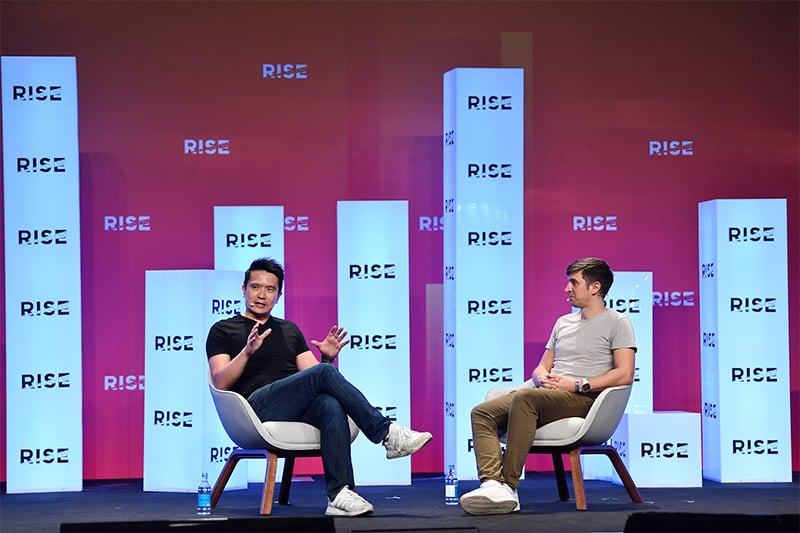Venturing into FinTech, gaming lifestyle brand Razer is taking the ESports world to the next level with digital payment system RazerPay, not to mention Razer Gold, a virtual credit system for buying in-game items and accessing exclusive content.
Razer, a global gaming hardware manufacturing company, was started as a side project of sorts by hardcore PC gamers Min-Liang Tan and Robert Krakoff in 2005. They had an idea to create a mouse designed specifically for gaming and the outcome was the Razer Diamondback. Today, the company is best known for building gaming peripherals, laptops and mobiles – something they do a lot of. Last year, the San Francisco and Singapore-headquartered company made USD 517.9 million in revenue, with a market value of USD 2.2 billion. But, they’re not stopping there. Recently, Razer announced a digital payment system RazerPay for their 60 million patrons to use in Southeast Asia. In an interview with TechCrunch’s Jon Russell at RISE 2019, the company’s charismatic founder and CEO Min-Liang Tan told a large crowd how his company’s connections with gamers around the world are opening up a whole new world of mobile payments.

Photo Credit: Stephen McCarthy/RISE via Sportsfile
Razer has come a long way from designing gaming hardware such as mice, controllers and keyboards. They released Razer Blade, a gaming laptop in 2011 that won many accolades, but since 2017, they’ve been focused largely on mobile and everything that surrounds it. “The whole mobile gaming business was considered more casual. But, with games like Candy Crush, we were seeing how processes were coming through with graphics capabilities,” explained Tan to the crowd at RISE. “So, that’s when we said, ‘Okay, how do we get mobile phones to the next level and potentially create an entire industry out of it?’ Our goal, fundamentally speaking, was to have users look at the mobile phone as a potential core gaming device. And we achieved that right after we launched the first Razer Phone.”
The Razer Phone took many by surprise when it debuted 2017 following the acquisition of Nextbit Systems, creator of the Robin, a Kickstarter-backed smartphone and a whole new breed of device. These ‘gaming phones’ weren’t for playing Candy Crush, but were designed for graphically-intensive titles that required longer and heavier gameplay. “If you look at all the gaming, all the mobile phone operators out there, everyone now has a gaming phone. And that’s what we’ve achieved.” By creating the ideal phone for hardcore gamers, they created an industry that’s invited other players to venture into – from Samsung and Asus to Xiaomi Gaming.
Having introduced the world to the gaming smartphone in 2017, Razer opened up a whole new area in which games such as Fortnite: Battle Royale, Minecraft and Pokemon Go could be played on devices like their later releases the Razer Phone 2 and Razer Cortex Mobile – a one-stop Android app launcher that aimed to better organise the games on your phone. Now they are working with mobile giant Tencent to build their mobile gaming strategy, optimising Tencent’s licensed games which include megahit Bluehole’s PUBG and Epic Games’ Fortnite. “We’re looking at accessories for mobile gaming. We’re looking at software for mobile gaming. We’re looking at services like Razer Gold that we can use for mobile gaming too.”
You might also like E-Sports Platform Introduces Crypto Cash To Competitive Gaming

Photo Credit: Stephen McCarthy/RISE via Sportsfile
They have also moved into Fintech with Razer Gold and Razer Silver, launched in 2017. Razer Gold is a virtual credit system (think cryptocurrency) for gamers that you can buy online and can be be used in over 2,500 games to purchase in-game items and gain access to exclusive content. Razer Silver is a loyalty rewards program, enabling gamers to redeem rewards. “Razer Gold is essentially one of the biggest virtual credits in the world used specifically for digital currency. And, we’ve also got a user base that is very familiar with the use of the digital wallet. So, it was a natural progression,” says Tan of why they took this route.
In addition, they’ve also ventured into the mobile wallet space with RazerPay. Already widely used in Malaysia and Singapore, Razer Pay is now expanding to the under-banked and under-served population in Southeast Asian countries like the Philippines. “Today at Razer, we actually process billions of dollars in terms of digital payments. We’ve got one of the biggest networks for payments in the emerging markets of Southeast Asia, Latin America, and the Middle East where gamers are coming onto the platform and changing fiat money for digital dollars. We have also started online payments for e-commerce sites like Lazada. Now, we’ve got one of the biggest networks in the world for FinTech and have kept it as a standalone entity.”
When talking about future projects, Tan expects to see more partnerships with companies and young millennials. They have recently announced a partnership with Visa. “We look at partnering with different companies. We’ve got a large network of mobile payments throughout the emerging markets. We’ve been laser-focused on our user base and we feel that the youth out there is incredibly unbanked. There’s so much that we can do over and above the traditional arm; I think financial services for the youth have been woefully inadequate. Visa is incredibly progressive with a massive network of users and an incredible technology platform out there – and they’re connecting with us to see how we can bring additional services across to the youth.”
Banner Photo Credit: Stephen McCarthy/RISE via Sportsfile
Related Articles
Streaming Giant Twitch On the Future of Streaming & Online Engagement
Tim Kobe Designed the First Apple Store. He Predicts Retail Future in Asia
The Billion Dollar Industry Growing Out of Bedrooms Around the World





